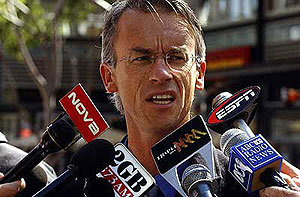
There are a lot of easy targets in the Sonny Bill Williams saga: the headstrong runaway who’s done the dirty on his mates, the conniving managers, and the aloof CEO hypocritically demanding support from an enemy that has been savagely plundered by his predecessors for over a hundred years.
All of them make great caricatures for the tabloid press and talk back radio stations, but are any of them playing out anything more than the inevitable?
It is sometimes said that the two World Wars were really just two acts of the same war, with a couple of decades gap in between. The same underlying issues that started World War One were never fully resolved, and as problems lingered, the world moved inevitably towards their terrible conclusion.
The problems that caused the Super League War that ripped apart rugby league in Australia during the mid 1990s still linger.
The compromised peace deal that brought the code back together left it in pretty much the same state it was before the commencement of hostilities, give or take a few clubs.
However, whilst the game has continued on in this no-man’s land, some new problems have emerged. Most importantly, rugby league is no longer at the top of the food chain in the rugby world.
For decades rugby league has been the bully in the Australian schoolyard and now the ARU has called in its big, French brother to come and give them a taste of their own medicine.
They should have seen it coming.
Rugby league could have spent the last decade getting its house in order. However, now the horse and Sonny Bill have bolted and foolhardy legal challenges are unlikely to have any effect.
The NRL faces some tough choices ahead and the coming World Cup will do little to plaster over the cracks.
The options are to continue as they have been, indignant, hypocritical and self-righteous, or to make the tough decision to face up to the realities that confront them.
The later almost certainly means restructuring the competition.
Perhaps there is a third way, a path through Moria, that would see the NRL adopt the ELVs and the rest of the rules of rugby with them. It won’t happen in one fell swoop but, just as the steady flow of individual players has trickled across over the last decade, it will happen one club at a time.
It will start with, for example, the Bulldogs fielding both an NRL and a Super rugby team that share the same facilities. Or the Broncos and the Reds merging.
Then, as union slowly grows with increased money from a lengthened Super rugby season, the league side will begin to dwindle as the NRL fails to restructure its competition.
The club’s board will follow the trail of cash right over to the dark side, slowly choking the 13 man team in the process, and before you know it, a great old league institution will have ‘converted’ in its entirety.
It might not happen exactly the way I’ve described it, but it is a scenario that definitely sits within the realms of possibility.
The club conversion described above is not a dream but a warning.
Restructuring appears inevitable for the NRL, but are they aware of how things have changed since the competition last shed clubs?
Rugby in Australia is arguably now in a position to pick up not only players discarded by a restructuring NRL, but entire clubs as well. If the game once again turned its back on Souths, you cannot tell me that John O’Neil and SANZAR wouldn’t consider offering their board a means of keeping the flame alive.
O’Neil’s desire for a fifth Australian Super rugby team is well known, and jilted fans may prove more fickle than league bosses might expect.
Can the NRL afford to not only lose a team and its supporters, but to gift them to its rival? Can it afford not to?
When Wendell Sailor left the Brisbane Broncos to join the Queensland Reds, the rugby league press said “we won’t miss him.”
When Lote Tuqiri and Matt Rogers followed, the rugby league press again said “we won’t miss him.”
As each of Gower, Gasnier, Tahu and Williams have gone, they are still saying “we won’t miss him.”
And now, as the next Australian rugby league player starts looking to maximise his pay packet, somewhere in France a rugby scout is assuring his boss, “we won’t miss him.”





























































































